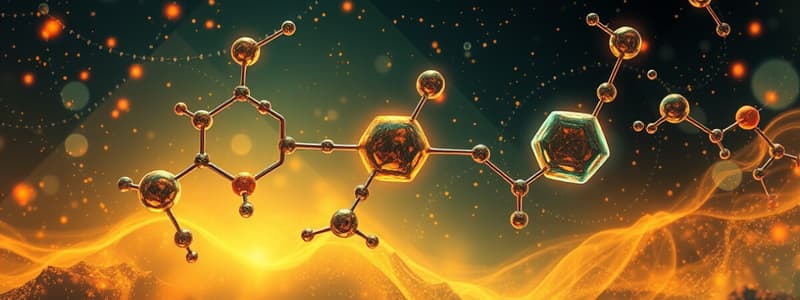Podcast
Questions and Answers
What type of hydrocarbon contains only single bonds?
What type of hydrocarbon contains only single bonds?
- Cycloalkanes
- Alkanes (correct)
- Alkenes
- Alkynes
Which functional group is characteristic of aldehydes?
Which functional group is characteristic of aldehydes?
- Amino (-NH2)
- Carboxyl (-COOH)
- Carbonyl (C=O) (correct)
- Hydroxyl (-OH)
What type of isomers have the same connectivity of atoms but differ in spatial arrangement?
What type of isomers have the same connectivity of atoms but differ in spatial arrangement?
- Geometric isomers
- Enantiomers
- Stereoisomers (correct)
- Structural isomers
In which type of reaction are atoms added to a double or triple bond?
In which type of reaction are atoms added to a double or triple bond?
Which step is NOT part of the systematic naming process of organic compounds according to IUPAC rules?
Which step is NOT part of the systematic naming process of organic compounds according to IUPAC rules?
What is the main difference between structural isomers and stereoisomers?
What is the main difference between structural isomers and stereoisomers?
Which of the following compounds is an example of an alkene?
Which of the following compounds is an example of an alkene?
What is the characteristic feature of carboxylic acids?
What is the characteristic feature of carboxylic acids?
Flashcards are hidden until you start studying
Study Notes
Overview of Organic Chemistry
- Branch of chemistry that studies the structure, properties, composition, reactions, and synthesis of carbon-containing compounds.
- Primarily involves compounds with carbon-hydrogen (C-H) bonds.
Key Concepts
-
Hydrocarbons
- Compounds composed solely of carbon and hydrogen.
- Types:
- Alkanes: Saturated hydrocarbons (single bonds; e.g., methane).
- Alkenes: Unsaturated hydrocarbons (at least one double bond; e.g., ethylene).
- Alkynes: Unsaturated hydrocarbons (at least one triple bond; e.g., acetylene).
-
Functional Groups
- Specific groups of atoms within molecules that determine the characteristics and reactions of those molecules.
- Common functional groups:
- Hydroxyl (-OH): Alcohols
- Carbonyl (C=O): Aldehydes and ketones
- Carboxyl (-COOH): Carboxylic acids
- Amino (-NH2): Amines
- Ester (-COO-): Esters
-
Isomerism
- Compounds with the same molecular formula but different structures.
- Types:
- Structural isomers: Different connectivity of atoms.
- Stereoisomers: Same connectivity but differ in spatial arrangement (cis-trans isomerism, enantiomers).
-
Reactions
- Organic reactions can be categorized based on the type of reactants and products:
- Addition reactions: Atoms are added to a double or triple bond.
- Elimination reactions: Atoms are removed, forming double or triple bonds.
- Substitution reactions: An atom or group is replaced by another atom or group.
- Rearrangement reactions: Atoms are rearranged to form a different compound.
- Organic reactions can be categorized based on the type of reactants and products:
-
Nomenclature
- Systematic naming of organic compounds based on IUPAC rules.
- Basic steps:
- Identify the longest carbon chain.
- Number the chain to give substituents the lowest possible numbers.
- Name the substituents and combine with the name of the main chain.
-
Synthesis and Mechanisms
- Study of how organic reactions occur, including reaction pathways and intermediates.
- Mechanisms often illustrate the movement of electrons (curly arrows).
-
Biomolecules
- Organic compounds that are vital for life.
- Categories:
- Carbohydrates: Sugars and starches.
- Proteins: Polymers of amino acids.
- Lipids: Fats and oils.
- Nucleic acids: DNA and RNA.
Applications of Organic Chemistry
- Pharmaceuticals: Development of medication and therapeutic agents.
- Agriculture: Creation of pesticides and fertilizers.
- Materials: Production of plastics, polymers, and industrial chemicals.
- Biochemistry: Understanding biological processes at a molecular level.
Overview of Organic Chemistry
- Focuses on carbon-containing compounds and their reactions.
- Includes compounds primarily characterized by carbon-hydrogen (C-H) bonds.
Key Concepts
-
Hydrocarbons
- Composed solely of carbon and hydrogen.
- Types include:
- Alkanes: Saturated, containing only single bonds (e.g., methane).
- Alkenes: Unsaturated, with at least one double bond (e.g., ethylene).
- Alkynes: Unsaturated, with at least one triple bond (e.g., acetylene).
-
Functional Groups
- Groups of atoms that define the behavior of organic molecules.
- Common functional groups include:
- Hydroxyl (-OH): Characteristic of alcohols.
- Carbonyl (C=O): Found in aldehydes and ketones.
- Carboxyl (-COOH): Defines carboxylic acids.
- Amino (-NH2): Present in amines.
- Ester (-COO-): Found in esters.
-
Isomerism
- Compounds can share a molecular formula yet have different structures.
- Types of isomers:
- Structural isomers: Variations in atom connectivity.
- Stereoisomers: Same connectivity but different spatial arrangements, including cis-trans isomers and enantiomers.
-
Reactions
- Organic reactions are classified by reactants and products:
- Addition reactions: Involve adding atoms to double or triple bonds.
- Elimination reactions: Atoms are removed, forming multiple bonds.
- Substitution reactions: Replacement of an atom or group.
- Rearrangement reactions: Atoms rearranged to create new compounds.
- Organic reactions are classified by reactants and products:
-
Nomenclature
- Systematic naming follows IUPAC rules.
- Steps include:
- Identifying the longest carbon chain.
- Numbering the chain to minimize substituent numbers.
- Naming substituents and combining with the main chain's name.
-
Synthesis and Mechanisms
- Examines reaction pathways and types through which organic reactions occur.
- Mechanistic studies often depict electron movement via curly arrows.
-
Biomolecules
- Essential organic compounds for life, categorized as:
- Carbohydrates: Includes sugars and starches.
- Proteins: Composed of amino acid polymers.
- Lipids: Consist of fats and oils.
- Nucleic acids: Involve DNA and RNA.
- Essential organic compounds for life, categorized as:
Applications of Organic Chemistry
- Pharmaceuticals: Crucial for developing medications and therapeutic agents.
- Agriculture: Involved in producing pesticides and fertilizers.
- Materials: Key to creating plastics, polymers, and various industrial chemicals.
- Biochemistry: Plays a role in elucidating biological processes at the molecular level.
Studying That Suits You
Use AI to generate personalized quizzes and flashcards to suit your learning preferences.




